Researchers Prepare Silicon Carbide-Polymer Composite Materials for SLS 3D Printing
Silicon carbide, or SiC, has a lot of potential for use in industrial applications, like aeronautic and aerospace engineering, the automotive industry, and the machinery industry, due to its excellent physical and chemical properties. But, because of the high production costs that come with mold manufacturing, machining, and high temperature and pressure sintering processes, this industrial use is rather limited.
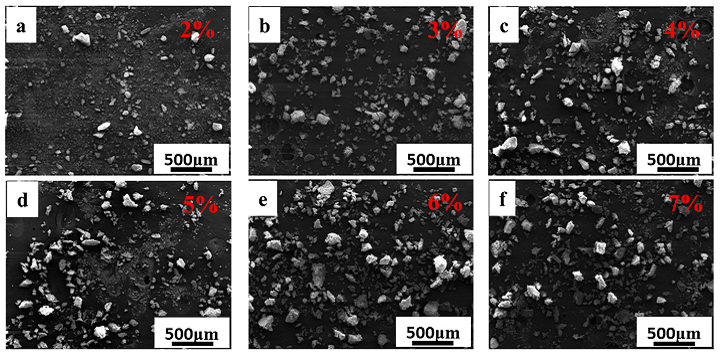
SEM images of SiC/PVB composite powders with the PVB binder contents in the range of 2 to 7 wt. %. (a–f) are 2 wt. %, 3 wt. %, 4 wt. %, 5 wt. %, 6 wt. % and 7 wt. %, respectively.
Selective laser sintering (SLS) 3D printing could be used to help lower these costs, and a collaborative team of Chinese researchers from the Southern University of Science and Technology, Southeast University, and the Harbin Institute of Technology recently published a paper, titled “Development of SiC/PVB Composite Powders for Selective Laser Sintering Additive Manufacturing of SiC,” that explains how they prepared SiC-polymer composites with good dispersity and flowability, using a ball milling method, for SLS 3D printing. By combining multiple materials into a composite material, completed components can benefit from the respective strengths of each material.
The abstract reads, “Subsphaeroidal SiC/polymer composite granules with good flowability for additive manufacturing/3D printing of SiC were prepared by ball milling with surface modification using polyvinyl butyral (PVB). PVB adheres to the particle surface of SiC to form a crosslinked network structure and keeps them combined with each other into light aggregates. The effects of PVB on the shape, size, phase composition, distribution and flowability of the polymer-ceramic composite powder were investigated in detail. Results show that the composite powder material has good laser absorptivity at wavelengths of lower than 500 nm.”
There are two approaches to manufacturing ceramic parts using SLS technology: direct and indirect. For this study, the researchers created their composite powder materials, using polyvinyl butyral (PVB) as a binder in order to investigate its effect on the powders’ surface modification, for indirect SLS processing.
“For indirect SLS processing, the polymers are used for a sacrificial binder phase,” the researchers explained. “There are three steps for indirect SLS: (a) The first step is to select a suitable ceramic and polymer phase to prepare ceramic/polymer composite powders as the starting materials of indirect SLS; (b) the second step is to use a laser to melt the organic phase in the ceramic/polymer composite powder, and then the ceramic particles will be bonded by the binder and the green parts are prepared; (c) the final step for indirect SLS is to remove the binder and sinter the green part to increase its density and strength.”
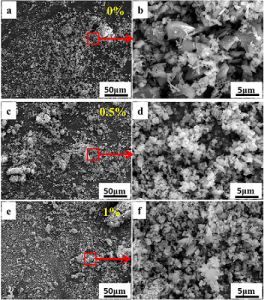
SEM images of SiC/PVB composite powders with different weight contents of the PVB binder. (a,b) for 0 wt. %; (c,d) for 0.5 wt. %; (e,f) for 1 wt. %.
As many commercial ceramic powders have irregular morphology and poor flowability, they’re not great for use in 3D printing. So the most important step of indirect SLS processing is the actual production of the polymer-ceramic composite powder agglomerates.
The team combined PVB, polyvinylpyrrolidone (PVP), and commercial SiC powder with anhydrous alcohol, and then ball milled the mixture at 120 rpm for 12 hours. The resulting powders were sieved through a 120 mesh screen, before a Concept Laser M2 was used to complete the composite’s preliminary spreading and forming tests.
The composite powder’s laser absorptivity was studied, and scanning electron microscopy (SEM) was used to examine the granulated particles’ morphology and microstructure, while X-ray diffraction identified the phase composition of the composite powders, laser diffraction measured the size of the agglomerates, and the materials’ UV-Vis analysis was also tested.
The researchers successfully prepared subsphaeroidal SiC/polymer composite granules, complete with good flowability, for SLS 3D printing, and added PVB binder to include surface modification. They investigated the effects of PVB on the distributions, flowability, shapes, and sizes of polymer-ceramic composite powder agglomerates, and determined some important information.
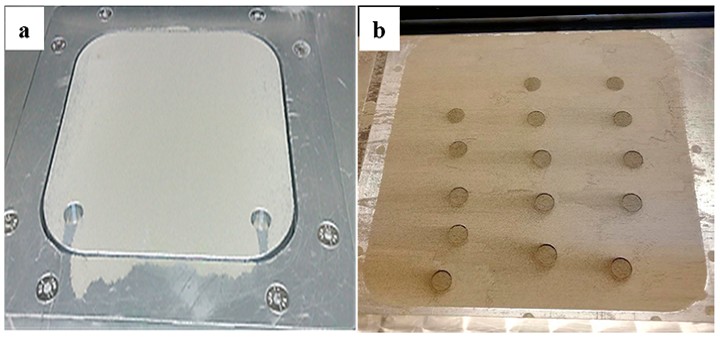
The typical spreading (a) and forming (b) tests of SiC/PVB composite powders with 3 wt. % binder addition using the 3D printing machine.
First, the added PVB has an optimal value (~3 wt. %), and the SiC granules modified with this material showed good spreading performance and flowability. In addition, when the wavelength is below 500 nm, the composite powder had good laser absorptivity, which suggests that using SLS 3D printing to fabricate the material could work with systems of a corresponding wavelength.
“Results show that the addition of the polymer binder improves the size distribution characteristic and flowability of the granulated particles within a certain range,” the researchers concluded. “However, when the PVB content increases to a higher value (e.g., more than 7 wt. %), greater addition of PVB will not have much influence on the apparent density, tap density, Carr index or Hausner ratio.”
Co-authors of the paper are Peng Zhou, Huilin Qi, Zhenye Zhu, Huang Qin, Hui Li, Chenglin Chu, and Ming Yan.
Discuss this research and other 3D printing topics at 3DPrintBoard.com or share your thoughts in the Facebook comments below.
3D Printing News Briefs: July 20, 2018
We’re starting out with some construction news in today’s 3D Printing News Briefs, then following that with a little business, a little metal, and a little 3D design. Russian firm AMT-SPETSAVIA has updated two of its construction 3D printers, and the University of New Brunswick has chosen a Concept Laser 3D printer to use for its upcoming research. Mass Portal’s software team went through a reorganization, and attendees learned all about lightweight aluminum material at the recent AMAP forum. Finally, users of browser-based SelfCAD 3D software can access the MyMiniFactory design library…and share their own work there as well.
Spetsavia Completes Updates on Large Construction 3D Printers
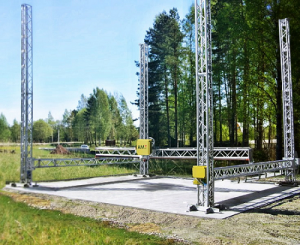 Three years ago, Russian firm Spetsavia presented its home construction methods and 3D printers at the 3D Print Expo. Now, the group of machining and 3D printing companies collectively known as AMT-SPECAVIA has updated its range of construction 3D printers (Construction Objects Printing or COP) to introduce two new large-format models. The S-300, with a “working field” of 11.5 x 11 x 5.4 m, is able to print directly on the foundation of buildings up to two stories and 120 square meters, while the S-500 features an 11.5 x 11 x 15 m field and can 3D print buildings up to five, or even six, floors. However, the latter can be increased to a working field of 40 x 11 x 80 m, which Spetsavia says makes it “the largest 3D construction printer in the world.”
Three years ago, Russian firm Spetsavia presented its home construction methods and 3D printers at the 3D Print Expo. Now, the group of machining and 3D printing companies collectively known as AMT-SPECAVIA has updated its range of construction 3D printers (Construction Objects Printing or COP) to introduce two new large-format models. The S-300, with a “working field” of 11.5 x 11 x 5.4 m, is able to print directly on the foundation of buildings up to two stories and 120 square meters, while the S-500 features an 11.5 x 11 x 15 m field and can 3D print buildings up to five, or even six, floors. However, the latter can be increased to a working field of 40 x 11 x 80 m, which Spetsavia says makes it “the largest 3D construction printer in the world.”
“New models of the S series are essentially the next generation of building printers. We’ve always been asked for a solution for multi-storey construction,” said Alexander Maslov, the General Director of AMT-SPETSAVIA. “Now we declare with confidence that such a solution exists! The AMT S300 and S500 printers are high-performance equipment with unprecedented capabilities and competitive price. During the development we’ve taken into account the wishes of the developing companies, at the same time maintaining the inherent reliability of our equipment, ease of management and maintenance.”
Both the S-300 and the S-500 have a direct flow print head for increased productivity, in addition to a new feed station that prepares the concrete mixture. The first shipment of the S-500 is scheduled for this fall, and a team of engineers will accompany the 3D printer to the customer for training.
University of New Brunswick to Use Concept Laser M2 Cusing
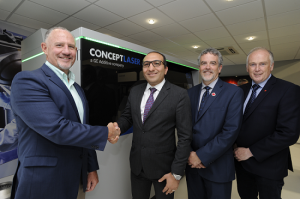
L-R: Keith Campbell, Senior Sales Director, GE Additive; Dr. Mohsen Mohammadi, Director of Research and Development for the Marine Additive Manufacturing Centre of Excellence; Hart Devitt, Director of Industry and Government Services; Duncan McSporran, Director, Programs and Innovation, Office of Research Services, University of New Brunswick
GE Additive has announced that the University of New Brunswick (UNB) in Canada, together with commercialization partner Custom Fabricators & Machinists and training partners Nova Scotia Community College (NSCC), New Brunswick Community College (NBCC), and the College communautaire du Nouveau-Brunswick (CCNB), has chosen its Concept Laser M2 Cusing metal 3D printer to use in its latest research.
UNB is in charge of the country’s first Marine Additive Manufacturing Center of Excellence, which will be the very first in Canada to fabricate certified parts for the marine industry with metal 3D printing. The M2 Cusing will mostly be used by UNB’s Dr. Mohsen Mohammadi, who will be the Director of Research and Development for the new center, and his team for multiple R&D areas, including bast resistance, enhanced corrosion protection, and hybrid 3D printing processes.
Mass Portal Announces Reorganization of Software Team
 Latvian 3D printer manufacturer Mass Portal has reorganized, and appointed new leadership for, its software team, which is now an independent company called FabControl. The company will be building an open, next-generation software platform for managing 3D printers and AM workflows, and Mass Portal’s current CEO and co-founder Janis Grinhofs, the founder of FabControl and in charge of developing Mass Portal’s flagship Pharaoh 3D printers, will now serve as the CEO of the new company. Imants Treidis has been named the new CEO of Mass Portal.
Latvian 3D printer manufacturer Mass Portal has reorganized, and appointed new leadership for, its software team, which is now an independent company called FabControl. The company will be building an open, next-generation software platform for managing 3D printers and AM workflows, and Mass Portal’s current CEO and co-founder Janis Grinhofs, the founder of FabControl and in charge of developing Mass Portal’s flagship Pharaoh 3D printers, will now serve as the CEO of the new company. Imants Treidis has been named the new CEO of Mass Portal.
“We will continue to serve our existing customers and industrial partners, in the same time striving for excellence in supplying the industry with highest quality machines and tailor built solutions for additive manufacturing needs,” Treidis said.
All About Aluminum at AMAP Forum
 Not too long ago in Aachen, scientific and industry experts gathered at the AMAP Forum (Advanced Metals and Processes) to demonstrate the continuing potential of researching non-ferrous metals, like aluminum, for the purposes of lightweight automotive design. 14 entrepreneurs from industry and five of the RWTH Aachen University institutions formed the AMAP Open Innovation Research cluster at the forum, and discussed topics ranging from new production technologies and materials development to modeling and metallurgic process technology. Some of the specifics included using aluminum hollow castings to create structural components with functional integration, additive manufacturing, and new design and calculation methods for high-strength aluminum alloys.
Not too long ago in Aachen, scientific and industry experts gathered at the AMAP Forum (Advanced Metals and Processes) to demonstrate the continuing potential of researching non-ferrous metals, like aluminum, for the purposes of lightweight automotive design. 14 entrepreneurs from industry and five of the RWTH Aachen University institutions formed the AMAP Open Innovation Research cluster at the forum, and discussed topics ranging from new production technologies and materials development to modeling and metallurgic process technology. Some of the specifics included using aluminum hollow castings to create structural components with functional integration, additive manufacturing, and new design and calculation methods for high-strength aluminum alloys.
Dr. Klaus Vieregge, Chairman of the AMAP Advisory Board and Head of the Hydro Aluminium Research and Development Center in Bonn, said, “We are an efficient network. New members are always welcome, but a high number of members is not the focus of the AMAP cluster, we want to convince people by the efficiency of the work and the research results.”
SelfCAD Partners with MyMiniFactory
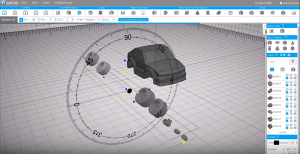 Online 3D design platform SelfCAD, founded in 2015, combines 3D modeling, slicing, and several other tools and functions in one easy program. Earlier this year, the platform announced a partnership with popular 3D printable model marketplace MyMiniFactory.
Online 3D design platform SelfCAD, founded in 2015, combines 3D modeling, slicing, and several other tools and functions in one easy program. Earlier this year, the platform announced a partnership with popular 3D printable model marketplace MyMiniFactory.
This partnership makes it easy for SelfCAD users to access the design library in MyMiniFactory, and also gives them the ability to download their 3D models directly from the marketplace while still in the SelfCAD program. In addition, it’s also possible for users to upload their models directly to MyMiniFactory for maximum exposure.
To learn more, check out this helpful video:
Discuss these stories and other 3D printing topics at 3DPrintBoard.com or share your thoughts in the Facebook comments below.
GE Additive Partnering Up with Honda and Triumph Group for 3D Printing Acceleration
 GE Additive, which is attending the Farnborough International Airshow this week, has been busily dropping announcements from the trade fair, the latest of which is centered around its AddWorks additive consulting service provider. GE Additive and AddWorks were chosen by the Honda R&D Co., Ltd, Aircraft Engine R&D Center in Japan to help increase the development of 3D printed aerospace applications for its future generation aircraft engines.
GE Additive, which is attending the Farnborough International Airshow this week, has been busily dropping announcements from the trade fair, the latest of which is centered around its AddWorks additive consulting service provider. GE Additive and AddWorks were chosen by the Honda R&D Co., Ltd, Aircraft Engine R&D Center in Japan to help increase the development of 3D printed aerospace applications for its future generation aircraft engines.
SmarTech Publishing stated that over $280 billion will be invested in additive manufacturing over the next decade, and GE Additive wants in. Last spring, the company announced that it would be increasing its focus on additive manufacturing, planning to sell 10,000 3D printers by 2026 and become a $1 billion business by 2020. This announcement was followed by setting up operations in Japan this winter, and announcing that more commercial offerings would be available last month. Now, it’s continuing to increase its commercial efforts in Japan by focusing on important industries like automotive and aerospace.
“We are pleased that Honda Aircraft Engine R&D Center has selected GE Additive to be its vendor in providing AddWorks consulting services to further the use of this transformative technology in its future generation aircraft engines,” said Thomas Pang, the Director of GE Additive in Japan. “We are in the best position to share our learnings from our own additive journey, having started from prototyping to successfully applying it to mass production for aviation engine parts.”
GE and Honda have been partnering together in the aviation industry for over ten years, first setting up the joint venture GE Honda Aero Engines LLC in 2004 between Honda Aero and GE Aviation, and then creating the GE Honda HF120 jet engine for use on lighter business jet aircraft like the successful HondaJet – the most delivered in its category last year.
To assist customers in adding 3D printing to their business workflows, GE Additive provides materials, 3D printers, and the engineering consultancy services of AddWorks; these consultants use their AM expertise to help clients figure out if adopting 3D printing will be beneficial in terms of performance and cost. GE Additive is hopeful that AddWorks will help Honda Aircraft Engine R&D Center, and ultimately lead to further growth of its partnership with the company and increased AM adoption in aerospace.
At its Japan location, GE Additive will sell Concept Laser and Arcam EBM 3D printers, along with materials, both directly and through local resellers to customers in the country that focus on heavy industry, automotive, and aerospace.
In addition to the partnership with Honda, Pennsylvania-headquartered Triumph Group, a leader in the aerospace industry, is working to further its own AM strategy by selecting two of GE Additive’s 3D printers and a variety of AddWorks design and engineering consultancy service packages. Triumph hopes that these new additions will help to support both its commercial objectives and its R&D initiatives.
“I really admire Triumph’s smart and progressive strategy in adopting a multimodality approach to their additive journey. And when you add to that the deep experience and divergent thinking of our AddWork’s team, I look forward to seeing the results of what I hope will be a long and rewarding relationship,” said Jason Oliver, the President and CEO of GE Additive.
 Triumph works in all levels of the aerospace supply chain, ranging from single components and complex systems to aerospace structures, in order to offer solutions for an aircraft’s entire product life cycle. The company enjoys a competitive advantage over similar businesses thanks to its ability to integrate several capabilities and products.
Triumph works in all levels of the aerospace supply chain, ranging from single components and complex systems to aerospace structures, in order to offer solutions for an aircraft’s entire product life cycle. The company enjoys a competitive advantage over similar businesses thanks to its ability to integrate several capabilities and products.
The aerospace company chose an M2 Cusing Multilaser DMLM system from Concept Laser, as well as an Arcam EBM Q20plus system, both of which should be fully installed at its Seattle R&D facility within Q3 of 2018.
“Triumph Group is excited to work with GE Additive to broaden Triumph’s utilization of additive manufacturing technology. Thus far we have successfully used additive manufacturing for prototyping, and we are rapidly growing its use for design competency,” said Dan Crowley, the President and CEO of Triumph Group. “This partnership with GE Additive will strengthen our additive manufacturing capability, accelerating our ability to design and develop future on-wing solutions for our customers.”

L-R: Gary Tenison, VP Strategy & Business Development, Triumph Group; Jason Oliver, President & CEO, GE Additive; Dan Rowley, President & CEO, Triumph Group; David Joyce, Vice Chair of GE and President and CEO, GE Aviation; Tom Holzthum, EVP Integrated Systems, Triumph Group; Ryan Martin, Sales Leader Americas, GE Additive
Right from the beginning, GE Additive’s AddWorks team will work with Triumph in multiple areas, such as advising on prototyping strategies, discovery workshops, and materials selection.
Discuss these stories and other 3D printing topics at 3DPrintBoard.com or share your thoughts in the comments below.
[Images provided by GE Additive]



